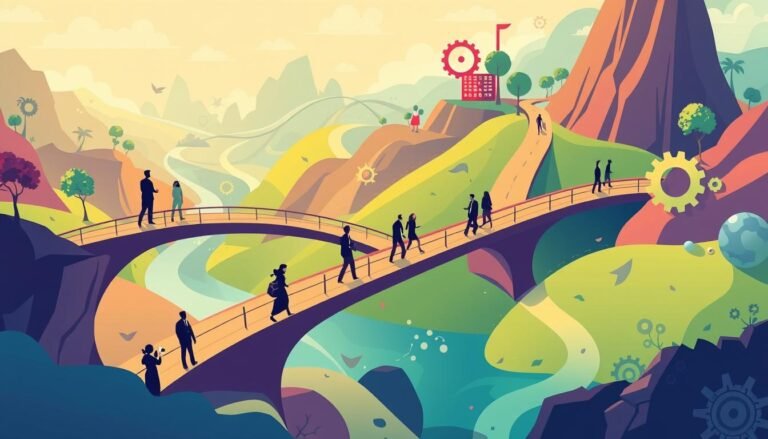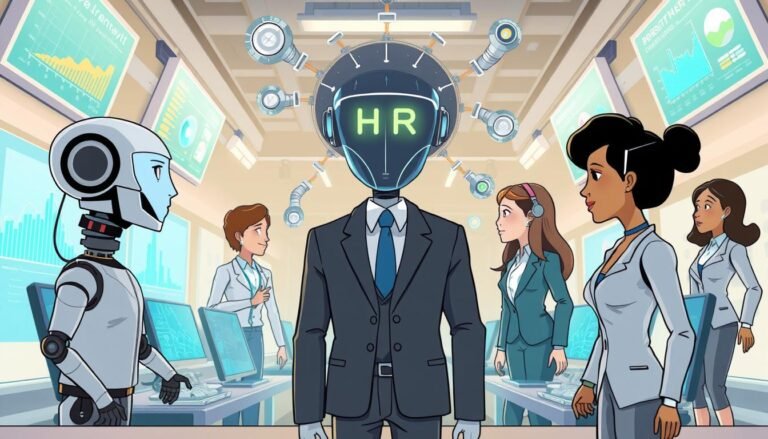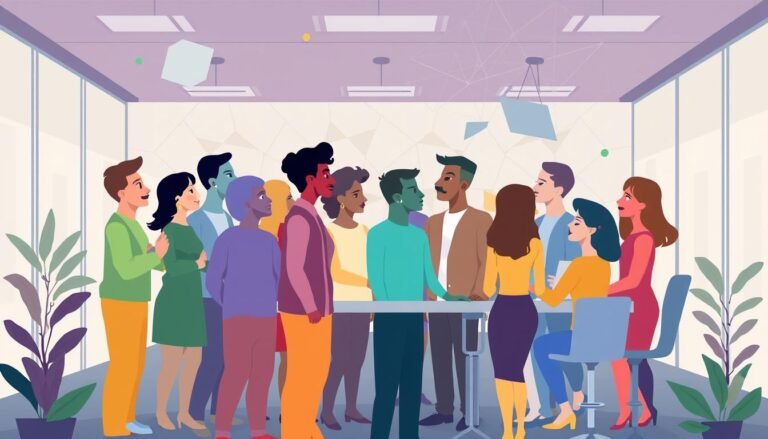Organizational Lifecycle Theory and HR Strategies
Organizations grow and change like living things. The Organizational Lifecycle Theory is key for HR strategies and talent management. It comes from Alfred Marshall’s 1890 work and helps businesses today.
Knowing the lifecycle of an organization is vital for planning the workforce. Each stage has its own challenges and chances for HR. From startups to big corporations, HR strategies must change to meet new needs.
The Organizational Lifecycle Theory has five stages: Infancy, Growth, Maturity, Decline, and Death. Not every company goes through all stages, and some change quickly. HR strategies need to be flexible to adapt to these changes and support the company’s goals.
In the early stages, HR focuses on getting talent and building a strong base. As companies grow, planning the workforce gets more complex. Mature companies need to keep employees engaged and innovative. Those in decline must handle downsizing and restructuring.
Key Takeaways
- Organizational Lifecycle Theory influences HR strategies at each stage
- Effective workforce planning adapts to different lifecycle phases
- HR challenges vary from talent acquisition in startups to engagement in mature firms
- Understanding lifecycle stages helps businesses prepare for transitions
- HR strategies must evolve to support organizational goals across all phases
Understanding Organizational Lifecycle Theory
Organizational lifecycle theory helps us see how businesses grow and change over time. It’s key for good Change Management and Organizational Development. Knowing the stages a company goes through helps leaders prepare for challenges and seize opportunities.
Definition and Key Concepts
This theory views organizations like living things, going through growth and development stages. Economist Alfred Marshall first talked about it in the 1890s. Later, other scholars built on his ideas. The lifecycle has five main stages:
- Conception
- Expansion
- Stability
- Growth
- Termination
Importance in Business Strategy
Knowing the lifecycle is crucial for business success. It helps manage resources, set priorities, and keep employees engaged. Not understanding these stages can cause a company to stagnate or decline.
Stages of the Lifecycle
Each stage of the lifecycle has its own challenges and chances:
| Stage | Focus | Key Activities |
|---|---|---|
| Start-up | Product Development | Capital accumulation, staff recruitment |
| Growth | Survival and Expansion | Establishing frameworks, pursuing growth |
| Maturity | Stability | Maintaining existing growth, efficiency |
| Decline | Revitalization | Innovation, restructuring |
| Termination | Exit Strategy | Asset liquidation, closure planning |
By matching strategies with these lifecycle stages, companies can smoothly navigate changes. This leads to ongoing growth and development.
The Stages of Organizational Growth
Organizations go through different phases, each with its own challenges and opportunities. Understanding these stages is key for effective Performance Management and Leadership Development.
Start-Up Phase
In the start-up phase, companies aim to survive and build a solid foundation. HR’s role is to find versatile talent and set up basic policies. They need agile Performance Management systems to quickly adapt to changing needs.
Growth Phase
As companies grow, they aim for stability and a good reputation. HR must scale processes and build a strong culture. Succession Planning is vital to keep leadership strong during rapid growth.
Maturity Phase
Mature organizations aim to stand out and be adaptable. HR focuses on making things more efficient and encouraging innovation. Leadership Development programs help keep the company competitive and ready for the future.
Decline Phase
In the decline phase, companies need to renew or transform. HR is key in managing change, retraining staff, and aligning the workforce with new goals. Performance Management systems must be updated to help turn the company around.
| Stage | HR Focus | Key Challenges |
|---|---|---|
| Start-Up | Talent Acquisition | Resource Management |
| Growth | Scaling Processes | Culture Development |
| Maturity | Efficiency Optimization | Innovation Fostering |
| Decline | Workforce Realignment | Change Management |
Each stage needs specific HR actions to meet the company’s needs and challenges. By matching HR strategies with these growth stages, companies can better manage their lifecycle and achieve lasting success.
Integrating HR Strategies with Lifecycle Stages
HR strategies are key for guiding organizations through their growth. They ensure the company grows well and stays stable. This is done through Workforce Planning and Organizational Development.
Tailoring HR Approaches by Lifecycle
Every stage of a company’s life needs its own HR plan. At the start, HR focuses on setting up systems and finding the right people. As the company grows, keeping things stable and building a good reputation becomes important.
When a company is mature, it focuses on being unique and adaptable. If it’s declining, it might need help restructuring. This is where HR strategies really shine.
Talent Acquisition at Different Stages
How a company recruits changes as it grows. Start-ups often use networking to find entrepreneurial talent. As companies get bigger, they use more formal processes to find specific skills.
A 2021 survey showed 63% of employees leave because they don’t see a future. This shows the importance of good talent management at every stage.
Employee Development Strategies
Developing employees is crucial at every stage of a company’s life. Job crafting can reduce burnout and make employees happier. Peer mentoring and recognition programs also boost engagement.
These strategies help manage talent well and improve how the company performs. They’re key to success.
| Lifecycle Stage | HR Focus | Key Strategy |
|---|---|---|
| Start-Up | Survival | Create viable systems |
| Growth | Stability | Structured recruitment |
| Maturity | Uniqueness | Employee development |
| Decline | Restructuring | Change Management |
Aligning HR strategies with the company’s lifecycle helps manage change well. It also supports ongoing growth. Regular checks with Key Performance Indicators keep these strategies working well for employees at all stages.
HR Challenges Across the Lifecycle
Every organization faces unique HR challenges as it grows. These challenges shape talent management and employee engagement. They vary from start-ups to mature companies.
Start-Up HR Challenges
Start-ups have limited resources and brand recognition. Nine out of ten workers value well-being as much as salary. It’s key for new companies to create appealing work environments.
Start-ups often rely on external investments or bootstrapping. This impacts their ability to offer competitive compensation packages.
Growth Phase Challenges
As companies expand, they must scale their workforce quickly. Performance management becomes more complex. It’s important to maintain quality while growing rapidly.
Organizations using Personio’s software for staff appraisals report smoother career development. The attraction stage is critical. Over 600 job boards are accessible through platforms like Personio for wider reach.
Maturity and Decline Challenges
Mature organizations struggle to keep employees engaged and adapt to market changes. Companies implementing Herzberg’s Two-Factor Theory see a 25% reduction in turnover rates. In decline, HR must manage downsizing while maintaining morale.
Comprehensive analysis of internal and external factors is essential. It helps address root causes of decline and plan for potential renewal or closure.
| Lifecycle Stage | Key HR Challenge | Impact on Performance |
|---|---|---|
| Start-Up | Limited Resources | 20% increase in employee satisfaction with effective needs addressing |
| Growth | Rapid Expansion | 15% improvement in overall employee performance metrics |
| Maturity | Employee Engagement | 25% growth in innovation output with upskilling investments |
| Decline | Workforce Reduction | 18% increase in organizational efficiency with systems approach |
The Role of Leadership in HR Strategies
Leadership is key in shaping HR strategies at every stage of a company’s life. As businesses grow, leaders must change their ways to tackle new challenges. This flexibility is vital for growing leaders and the company itself.
Leadership Styles Across Lifecycle Stages
Leadership styles change as companies grow. At the start, leaders focus on vision and new ideas. As companies get bigger, they need leaders who can manage teams well.
When companies reach maturity, leaders must balance keeping things stable while always looking to improve.
Influence on HR Strategy Effectiveness
Leadership greatly affects how well HR strategies work. Leaders set the culture and guide the company’s direction. A study in the banking industry found that succession planning, leadership, training, and evaluations are crucial.
Many companies spend a lot on leadership programs but struggle with succession planning. It’s important to plan for the future by identifying key roles and assessing current leaders. This helps the company grow and serve the community better.
“Effective leadership is not just about managing today’s challenges, but preparing for tomorrow’s opportunities.”
In China, where companies don’t last as long as in the West, leadership is even more vital. With short lifespans, leaders must be adaptable and have strong HR plans. This shows the need for ongoing leadership development and effective change management.
Aligning HR Metrics to Lifecycle
HR metrics are key in managing performance and planning the workforce at different stages. As companies grow, their focus changes. This means they need to adjust their talent management strategies.
Key Performance Indicators (KPIs)
KPIs change as companies grow. Start-ups focus on hiring fast and basic productivity. When they grow, keeping employees and training them well become key.
As companies mature, they look at how happy their employees are and who can take over roles. This shows how important it is to plan for the future.
Evaluation Techniques Per Phase
How companies evaluate their employees changes as they grow. Small businesses often use simple checks. But bigger companies use detailed data analysis.
This change helps them handle more complex workforce planning needs.
Using Data for Strategic Decisions
Using HR data becomes more important as companies grow. Gallup found that companies with strong HR get four times more profit per employee. This shows how important good HR management is for success.
| Lifecycle Stage | Key HR Focus | Primary Metrics |
|---|---|---|
| Start-up | Talent Acquisition | Time-to-hire, Cost-per-hire |
| Growth | Employee Development | Training ROI, Retention Rate |
| Maturity | Performance Optimization | Productivity, Engagement Scores |
Aligning HR metrics with the company’s lifecycle helps make better decisions. This ensures HR practices keep up with business needs. It leads to long-term success.
Best Practices for HR Management in Organizations
HR management is key to an organization’s success. A study of over 2,000 small businesses showed that fast-growing ones adopted HR best practices 20% more often. Let’s look at important strategies for effective HR management in different areas of organizational development.
Communication Strategies
Clear communication is crucial for keeping employees engaged. HR should use various channels to reach everyone in the organization. This includes team meetings, company newsletters, and digital platforms for quick updates.
Employee Engagement Initiatives
Boosting employee engagement is vital for growth. High performers are 200-300% more productive than average. HR can improve engagement by:
- Starting recognition programs
- Providing chances for professional growth
- Supporting work-life balance
- Boosting diversity and inclusion
Change Management Practices
Good change management is key for growth. HR can lead change by:
- Sharing change news clearly and often
- Offering training and support during changes
- Quickly addressing employee worries
- Celebrating achievements
Using these best practices can greatly improve HR management. It leads to better employee engagement, smoother changes, and overall success.
| HR Best Practice | Impact |
|---|---|
| Selective Hiring | Improved job fit and organizational value |
| Self-managed Teams | Enhanced innovation and psychological safety |
| Emotional Intelligence Training | Better teamwork and collaboration |
| Strategic HR Involvement | Alignment with organizational goals |
Case Studies Demonstrating Lifecycle in HR
Real-world examples show how HR strategies are shaped by organizational lifecycle theory. We’ll look at success stories, lessons from failures, and cases from different industries. These highlight the need to match talent management with organizational development.
Success Stories
Google is a great example of effective talent management. The tech giant keeps its culture fresh by focusing on employee engagement and leadership development. Here’s how they do it:
- They offer unique perks to attract the best talent.
- They use peer-based recognition programs.
- They encourage continuous learning and skill development.
Lessons from Failures
Kodak’s failure to adapt to digital technology is a lesson for all. Their inability to update their talent strategy led to:
- They couldn’t keep innovative employees.
- They didn’t focus on developing new skills.
- They were resistant to change in their culture.
Industry-Specific Examples
Different industries face unique challenges at different lifecycle stages. For example, in healthcare:
| Lifecycle Stage | HR Focus | Key Strategy |
|---|---|---|
| Start-up | Talent Acquisition | Attracting specialized medical professionals |
| Growth | Training & Development | Upskilling staff for new medical technologies |
| Maturity | Retention | Implementing work-life balance initiatives |
These examples show how crucial HR is in navigating organizational lifecycles. By matching talent management strategies with each stage, companies can grow, innovate, and succeed in the long run.
Future Trends in Organizational Lifecycle and HR
The world of organizational lifecycle theory and HR is changing fast. New tech and data analytics are changing how companies plan their workforce and manage change. This change opens up new ways for organizations to grow and succeed in today’s fast world.
Impact of Technology on Lifecycle Theory
New tech is changing old ways of organizing companies. The rise of the gig economy is changing how we see employee lifecycles. This means HR needs to update its strategies for managing performance.
Artificial intelligence and machine learning are changing how HR plans for the future. These tools help HR make smart choices about hiring and training. This way, companies can match their human resources with each lifecycle stage better than ever.
Predictive Analytics and HR
Predictive analytics is changing how HR makes decisions. By looking at past data, HR can predict future trends and get ready for changes. This helps in managing change and improving performance.
| Trend | Impact on HR | Adoption Rate |
|---|---|---|
| AI in Workforce Planning | Enhanced talent forecasting | 65% |
| Predictive Analytics | Improved decision-making | 78% |
| Gig Economy Integration | Flexible workforce management | 52% |
As companies use these new technologies, HR strategies are getting more flexible and quick to adapt. The focus is now on constant change and being ready for anything. This ensures companies can handle the challenges of each lifecycle stage with confidence.
Conclusion: The Synergy of Lifecycle Theory and HR
Organizational Lifecycle Theory gives HR a new way to look at their strategies. It helps them adjust as companies grow and change. By knowing each growth stage, HR can support the business better.
Summarizing Key Insights
HR strategies are key for guiding companies through different stages. For example, in the start-up phase, HR builds a strong team. In the growth stage, they focus on developing leaders. The maturity phase requires keeping employees engaged.
These specific strategies help companies succeed at every stage.
The Road Ahead for HR Strategies
HR strategies will need to keep up with technology and work changes. Making decisions based on data will become more crucial. HR will use tools like predictive analytics to anticipate and solve problems.
This proactive approach will help companies stay competitive in a fast-changing world.
By linking HR strategies with Organizational Development goals, companies can increase their success chances. The future of HR is about being flexible and adapting, just like the organizations it supports. As businesses evolve, so will the important role of HR in guiding them through each stage.
Source Links
- Understanding Organizational Lifecycle Theory: Navigating Stages of Growth and Renewal
- Organizational Life Cycle (Adizes)
- Organizational Life Cycles: A Brief Overview
- Organizational life cycle models: a design perspective
- Organizational Life Cycle – Definition, Stages, Importance
- Understanding and Optimizing the Organizational Life Cycle
- The Five Stages of Organizational Development (Explained Clearly)
- Employee Life Cycle: What it is, Stages and Management
- Organizational Life Cycle Stages: Challenge & Solutions | Welllhub
- What is the Employee Life Cycle? The 6 Stages for HR Leaders
- Online HR Software | Global leader in Cloud based HR – trusted by 28,000 Companies in 200 Countries
- Succession Planning: Strategies HR Managers Use To Fill Key Leadership Positions
- A Study of the Impact of Strategic Human Resource Management on Organizational Resilience
- Strategic HR’s Place in Organizational Development – SSR
- Why Aligning HR Planning with Business Strategy is Essential for Business Success • MBA Notes by TheMBA.Institute
- 10 HR Best Practices For Business Success in 2025
- Practicing Strategic Human Resources
- Employee Life Cycle: The Ultimate Guide for HR
- The new possible: How HR can help build the organization of the future
- Organizational Life Cycle: Definition, Models, and Stages
- What are HR Theories? Types and Meaning
- A Review Of The Literature On Human Resource Development: Leveraging Hr As Strategic Partner In The High Performance Organization
- Understanding the Human Resources Life Cycle: A Comprehensive Guide








